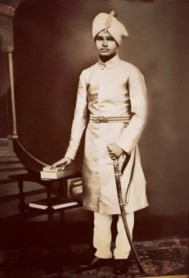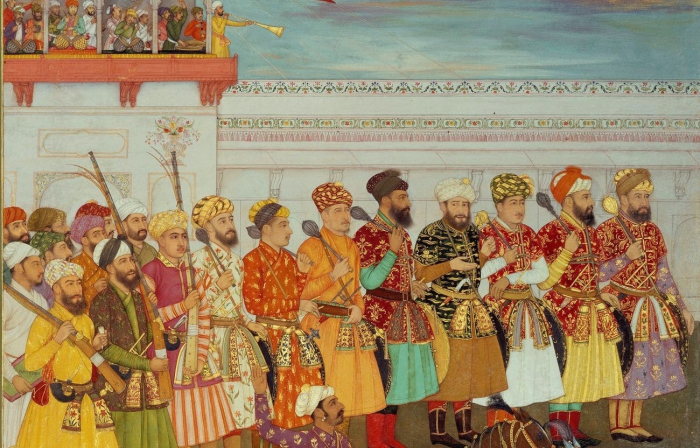

In the middle ages, the kingdoms were completely dependent on the land revenue collected by the peasants. During the Delhi sultanate, the kings had divided provinces among their trusted ministers and gave them the right to collect taxes. One of the most important dynasties to rule India for approx two centuries was the Mughal Dynasty.
Mughals developed a sound system for revenue collection. The main source of income came from land revenue. Akbar classified lands and fixed the revenue for each kind of land. The office of diwan was created to overlook the fiscal system of the empire. There were multiple institutions created during the Mughal empire, which included, the Jagirdari system, Mansabdari system and Zamindari system. Mughals considered all middle chiefs who wielded some kind of power in their region and acted as a bridge between locals and the empire. Generally, the Zamindars were local chieftains.
Zamindars of Gopala dynasty
HindustaniHindu, CC BY-SA 4.0

Chieftains in Mughal Court
Abd al-Hamid Lahawri (author)Ramdas (Illustrator), CC BY 2.5
Akbar introduced a policy of assessment of all agricultural land through continuous surveys to determine the average yield from all kinds of land. In these assessments, the variables like drought and floods were focused on. Peasants were given relaxation during these natural calamities. The system of revenue collection based on such assessment was called Zabt or Zabti system.
The Zabti system was further developed into the dahsala system. It was a land revenue system monitored by Akbar’s revenue minister Todar Mal. He conducted a survey of land, yields and prices of products for ten-year period, from 1570 to 1580. Based on the findings of his assessment he fixed the tax on each crop. In the zabti system, the preferred way of revenue was in cash. There was another system of revenue collection, called the batai system. It was the oldest form of revenue collection from peasants. In batai, the peasants had to give a certain share of produce to the kingdom. During cultivation in the presence of a royal office, the share of produce as revenue was harvested. The peasants were allowed to choose between Zabti and batai systems.
Zamindars during the Mughal period were a class of people who enjoyed certain powers in the countryside.
They were dependent o agriculture but did not participate in the agricultural process.
Zamindars were rural elites who could be village heads or local chieftains.
Zamindars were big landowners, these properties were called milkiyats. They had total control of such lands. They enjoyed hereditary rights on these lands.
Zamindars generally belonged to the upper caste like Brahmans and Rajputs. Later a new class of Muslim Zamindars emerged.
Zamindars were ruler elites who enjoyed certain property rights and had a private military. They usually lived in fortresses and their position was hereditary. The Mughal kings had allowed the zamindars to follow their old traditions and they enjoyed their property rights in the countryside. The Zamindars had two important roles.
Firstly, they had the right to collect taxes on the behalf of the state and zamindars were paid for their services. These zamindars adopted very harsh methods for revenue collection. They often came in conflict with the peasants which they subdued with their military strength.
Secondly, they enjoyed the privileges of keeping a private army. They had their armed contingent which included, the cavalry, infantry and artillery. Most of the Zamindars had fortresses where they stationed their armies. In ain-e-Akbari, there is mention of a parallel army which was a combined army of such Zamindars.
The consolidation of Zamindari was a slow process. People belonging to the lower caste had to go through many processes to buy zamindari. In the Mughal period, the Zamindari was sold by the state and it was a long process. Firstly one had to either colonise new land or buy from the state. The process of consolidation was mostly seen in the lineage-based Zamindari. Jats and Rajputs used the methods of colonising the new agricultural land and buying the lands from the state to increase their power in northern India. These Zamindars settled and brought peasants to these new cultivable land and helped them with loans and resources to cultivate. With this process, they gained more and more revenue, which later strengthened their power.
The formation of new Zamindars and new cultivable land gave rise to many villages. The Zamindars enjoyed the produce from their milkiyat and they had the right to sell products of mikiyat. The rise of Haats in villages was seen during this time it was a marketplace where the zamindars and villagers came to sell or buy the produces.
The Zamindars are generally considered exploitative in their practices, but in historical records, it is not present. In the writings of Bhakti saints, they did not consider the Zamindars as exploiters of the peasantry but the revenue collectors were seen as exploiters. In some areas, it was found out that Zamindars with their peasantry of the same caste sometimes rebelled against the Mughal empire and fought against the exploitation of the state.
The consolidation of big empires gave rise to the complex bureaucracy. Mughal empire had many institutions like Mansabdar, Jagridar and Zamindars. The main sources of income for the kingdom as land revenue and taxes. The land revenue during Akbar's period was based on an assessment of lands and the different amount was taken from different lands. This system of assessment in taking revenue was called Zabt. Another rural elite class the Zamindars had a certain power and hereditary right to property, which was called milkiyat. Zamindars enjoyed the production of their milkiyat and they work for the state as their revenue collectors.
Q1. What was Zabt?
Ans. Zabt was a policy or collection of land revenue. It was introduced in Akbar’s time, in this policy, the assessments of lands were done and the peasants were exempted from paying taxes during drought and floods.
Q2. What was dahsala?
Ans. It was an extension of Zabt policy. It was formulated by Todar Mal, the revenue minister of Akbar. According to this policy the total yield of 10 years of any land was calculated and the average was imposed as tax.
Q3. Who were Zamindars?
Ans. Jamindars were rural elites who hold hereditary rights on their property and had their private army.
Q4. What is the difference between Zabt and Batai?
Ans. Zabt was land revenue paid in cash, whereas Batai was revenue which was paid in produce from the land.
Q5. What was the role of Zamindars?
Ans. Zamindars collected taxes from presents on behalf of the state and they provide their army for the military campaign by the ruler.